Mold in the Wall – Wall Mold Removal and Remediation
Mold at Your Home or Business? We Can Help!

No matter what wall mold damage situation you’re dealing with, we have solutions.
Mold growth on your walls is an urgent issue because mold quickly eats through drywall which can cause serious structural damage. If you find mold growth on your walls, make sure you immediately take the following steps:
- Step 1: Try to avoid affected areas so you do not put your health at risk. When entering affected areas, make sure to protect yourself with gloves, safety eyewear, a mask, and long pants and sleeves.
- Step 2: Evaluate the extent of the mold the best you can. You will need to call a professional if the mold has affected an area larger than 10 square feet or has been there for more than 24 hours.
- Step 3: If you can find the source of the moisture that caused the mold, whether it’s a leak or poor ventilation, fix the problem to prevent further mold growth.
- Step 4: Call a professional to assess the mold growth and start the remediation. When mold appears on the walls, it is possible that there is more mold hidden behind the walls.
Call RestorationMaster for Wall Mold Removal
Mold growth on and within your walls will only get worse until it is removed. Make sure you contact a mold remediation professional as soon as you find mold on your walls.
Call RestorationMaster at (888) 915-7197 to find a mold remediation specialist near you.
Mold in the Wall – Who to Call?
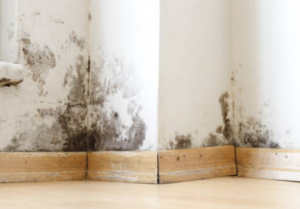
If you find mold growth on or within your walls, call RestorationMaster right away at (888) 915-7197 to find a mold remediation specialist in your area.
Wall Mold Removal and Remediation – What to Expect?
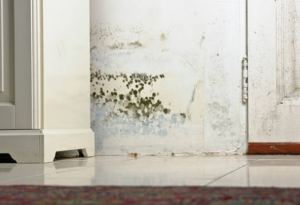
Mold remediation experts will start by uncovering all mold growth, including hidden mold, and isolate the affected areas. During the mold remediation process, damaged drywall will likely have to be removed and replaced after the mold removal.
Choosing the Right Mold Removal Service for Walls – Why RestorationMaster?

RestorationMaster has worked with the best mold remediation professionals across the U.S. for 11 years and we can put you in touch with a mold removal specialist near you.
Residential Wall Mold Removal and Remediation
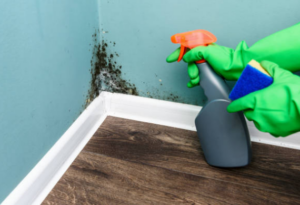
When mold appears on the walls in your home, there may also be mold growing behind the walls. Mold remediation specialists will find all mold growth within your home and safely remove the mold as well as permanently damaged drywall and insulation materials.
Commercial Wall Mold Removal and Remediation

A mold problem within the walls of a commercial building could lead to extensive property damage while posing a significant health risk. Mold remediation specialists can provide wall mold removal for commercial buildings to remove the mold growth and restore the resulting damage.
Emergency Wall Mold Removal Service – Call (888) 915-7197 Now
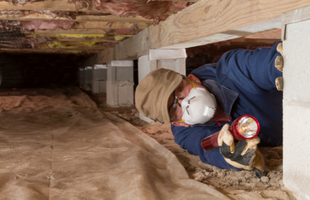
Mold on and within your walls is an emergency because the damage caused by the mold can cause the drywall to collapse. Call RestorationMaster at (888) 915-7197 right away to find a mold remediation professional in your area.
Contact a local mold remediation contractor in your area:
Wall Mold Removal FAQs
All mold types need an organic food source like cellulose to survive, therefore, there are several mold types that can appear on and within your walls. You should look out for the following types of mold on your walls:
• Black mold on wall
• Green mold on walls
• Blue mold on wall
• Yellow mold on wall
It is obvious when mold appears on the visible side of the wall, but the signs of mold behind the walls are more subtle. Recognizing the signs of mold on and within your walls will allow you to act quicker and help prevent more significant damage.
The following are the signs of mold on the walls:
• Mold growth on walls
• Mildew smell in walls
• Stains or dark spots in visible side of wall
• Bubbling of the drywall
• Peeling wallpaper
• Soft drywall
The damage from mold growth on and within the walls can be extensive and lead to significant structural damage. Make sure to call us at (888) 915-7197 to be put in touch with a mold remediation professional.
Drywall is already susceptible to mold growth because it contains cellulose which is a major food source for mold. When drywall is affected by excess water or moisture, mold growth can appear on and within the walls.
The following are the main causes of mold on the walls:
• Humidity and condensation
• Water leaks from the roof or burst pipes
• Overflows or leaks from plumbing fixtures and appliances
• Flooding
• Poor ventilation
Mold growth on your walls will spread quickly as it eats away at the drywall which can eventually cause structural damage. This is why you need to call a mold remediation professional once you find mold growth on your walls.
Wall mold removal services include the following:
• Mold inspection
• Mold remediation
• Mold removal
• Mold cleanup
• Mold treatment
• Mold abatement
Mold growth can cause significant structural damage if it appears on or within your walls which is why you need to call a professional right away. You can find a mold remediation specialist in your area by calling RMF at (888) 915-7197.
The cost to remove mold from drywall ranges from $1000 to $12,000 to depending on the extent of the damage and the type of mold. The cost will be much higher if the mold growth started behind the wall and has affected the drywall, insulation, wood beams, and wallpaper as these materials may have to be removed and replaced.
Homeowner’s insurance can cover the cost of removing mold from the walls if the mold was caused by a covered peril. This may include burst pipes, appliance malfunctions, plumbing leaks, and overflows that have created the conditions for mold to grow. When insurance does cover mold removal, there is usually a maximum limit on what they will cover. Additional mold coverage policies increase what insurance will cover.
Homeowner’s insurance will not cover mold removal from walls if the mold was caused by neglect, including poor ventilation or leaks that have not been fixed. Typical insurance policies do not cover mold caused by flooding or water damage from outside the home as this would require a separate flood insurance policy.
As discussed above, mold can cause considerable damage to drywall if the problem is not quickly addressed. However, if you find visible mold on your walls before it has spread and taken hold, you may be able to remove it yourself. You should call a professional if the mold has spread beyond an area of 10 square feet.
You can remove mold from the drywall with the following steps:
• Stop the moisture: Mold typically appears on walls when there is a moisture source like a leak. Find and fix the moisture source to prevent further mold growth.
• Protect yourself: Use protective gear including safety goggles, gloves, a mask, and long sleeves and pants.
• Determine if the drywall can be saved: If the drywall is soft to the touch and may have lost some of its structural integrity, it may be better to remove and replace the drywall. If the drywall is mostly dry and still structurally sound, you can clean the mold from the surface.
• Vacuum the wall: Using a vacuum with a HEPA filter, vacuum the mold spots on the wall to remove the spores from the surface.
• Kill the mold: To effectively kill and remove the mold, you should use a 2:1:1 mixture of baking soda, white vinegar, and water respectively, or 3% hydrogen peroxide. Bleach is not a good option for drywall because it does not penetrate the surface to kill the mold within the materials. Spray the solution you choose on the spots and let it sit for 10 minutes before scrubbing with a medium bristled brush. Then wipe away remaining residue.
• Dry the wall: Set up a fan and point it at the affected spot to dry the wall.
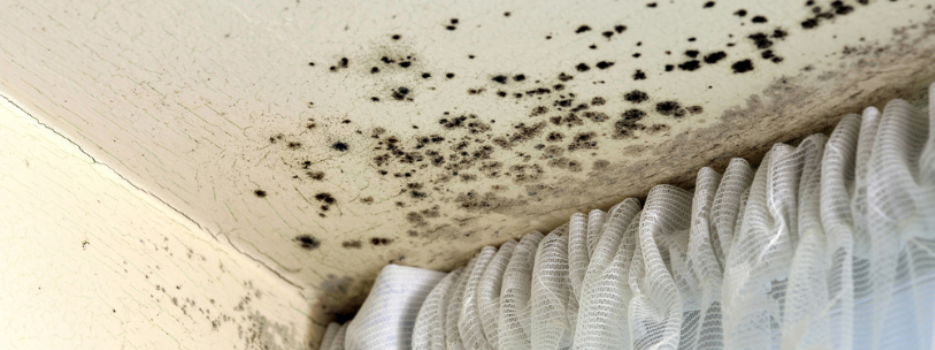
Related Posts
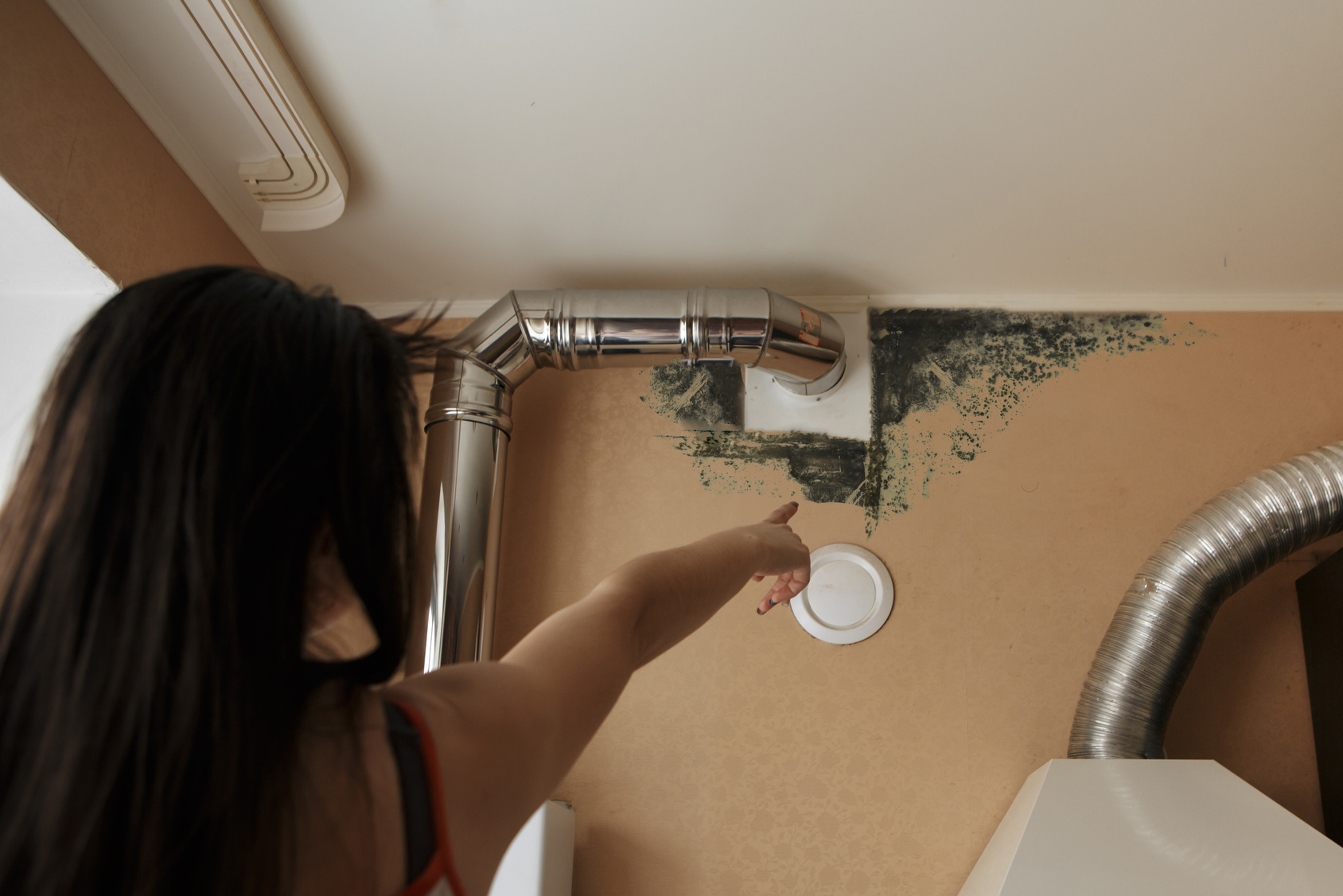
How to Detect Mold In the Walls
Knowing the amount of damage mold can cause, it is important for you to know how to detect mold in your home. However, it can sometimes be difficult to spot mold because it can be hidden. Here’s what to look for when finding mold behind the walls.
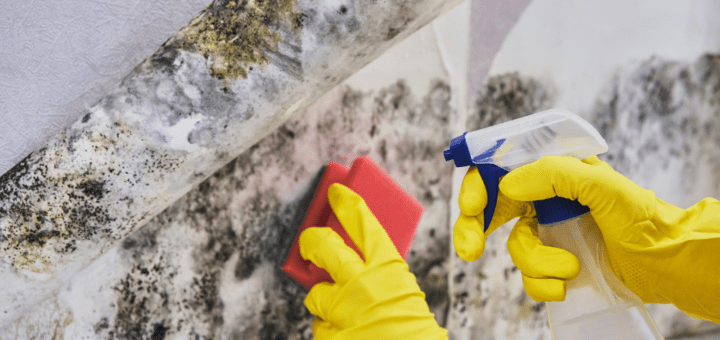
Removing Black Mold from Walls
If you experience a mold outbreak on your basement walls, it could be a major issue as it can cause staining on your walls, bad odors as the mold spores spread, and health issues. Follow these tips for removing black mold from basement walls.
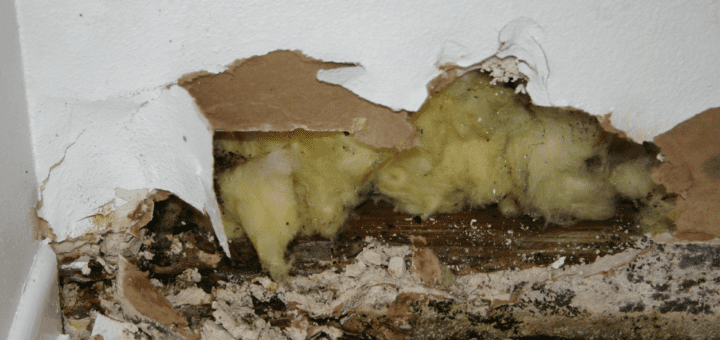
Should I Use Mold Resistant Drywall?
It is important to know how mold grows and how it can affect the structure of your home. There are different types of mold that can develop on your property, however, installing mold-resistant drywall in specific areas can help you avoid it altogether.
